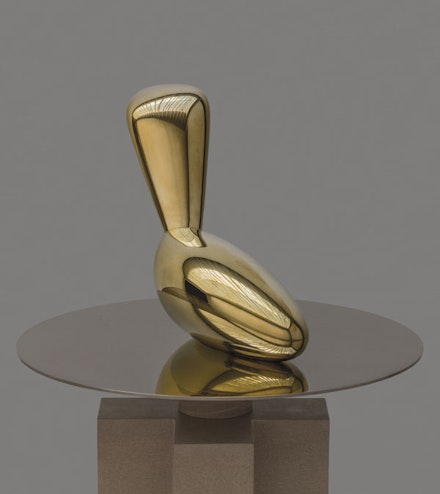ArtSeen
Brancusi & Duchamp: the Art of Dialogue
On View
Paul KasminSeptember 20 – December 22, 2018
New York
It would be difficult to come up with a more challenging duo than this one. The exhibition is packed with sculptures, photographs, objects, films, little magazines—nothing is lacking—but we could just stop where it starts: with those two gorgeous faces of Brancusi and Duchamp by Man Ray, from 1920 and 1934, preceded by a sweater-clad Brancusi rarely seen. Here we are given the proper spin to this remarkable dialogue.
I will hone in on what most pulled me in: the extraordinary Recording of Puns by Rrose Sélavy, originally recorded in 1950 and copied in 1967 – 1968. To watch the hypnotizing spirals of Anemic Cinema, accompanied by the camera used to make it in 1920(!), or the Rotoreliefs and optical disks from 1930 and 1935 spinning in the present, while we hear the puns said aloud by Duchamp—as his alter ego (ega!) Rrose Sélavy—adds a whole other layer of meaning and experience. Of course, as the surrealists always said, “words are not playing, they are making love” and this sounding, alongside the Brancusi films of the early 1930s, was something literally unheard before.
But then there are Brancusi’s photographs of the external world such as the Temple of the Crocodile and the Endless Column at Voulangis that seems somehow to end in the sky, or his interior world—his studio, his and Duchamp’s friend Henri-Pierre Roché, with his face thrice averted, and—my favorite—Brancusi’s self-portrait in his studio of 1922. All are revelations rather than representations, as were his portraits of James Joyce in 1929 and one of an anonymous woman in 1920, whose face (so resembling Brancusi’s sculpted faces like that of Mlle Pogany) is inserted in the upsweep of her dress, all in green and red. But even more startlingly, another portrait from 1917, has just the face of Duchamp as Rrose Sélavy with that hat and those hands by Man Ray—ah, how we recognize her!
But nothing surpasses Brancusi’s film of the Inauguration of the Large Fireplace of 1932, with Duchamp, Mary Reynolds, Vera Moore and Brancusi seated around a table celebrating. What a conversation is this! And if that is about hearing and seeing in the round, the ultimate transparency is surely Hans Schiff’s print of Duchamp’s Large Glass with Brancusi’s Leda seen through it (1949, printed in 1956 – 7). Dialogues like this—rare and unprecedented—are about speaking and seeing and making art through and around.



